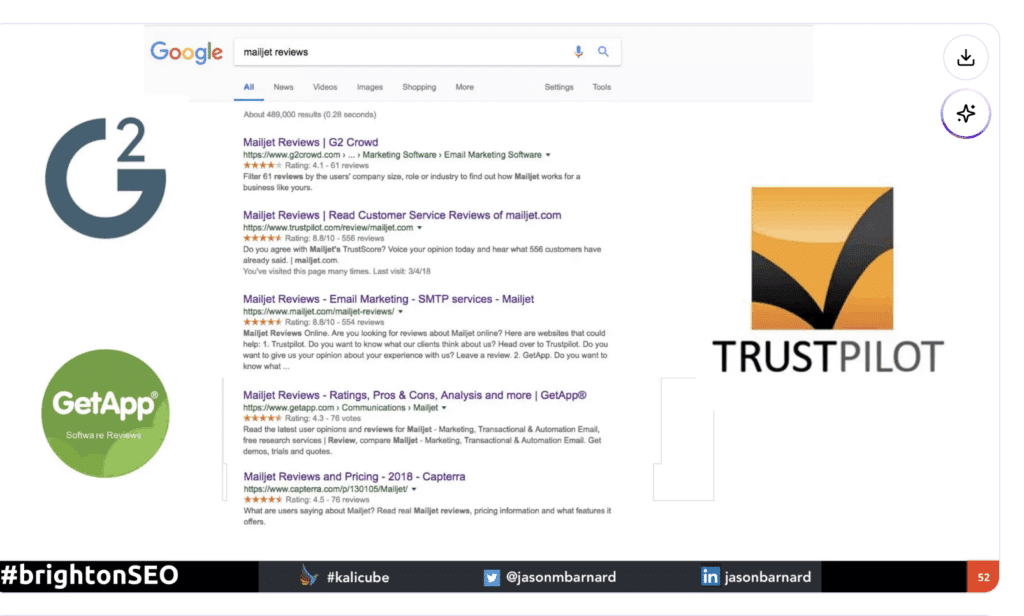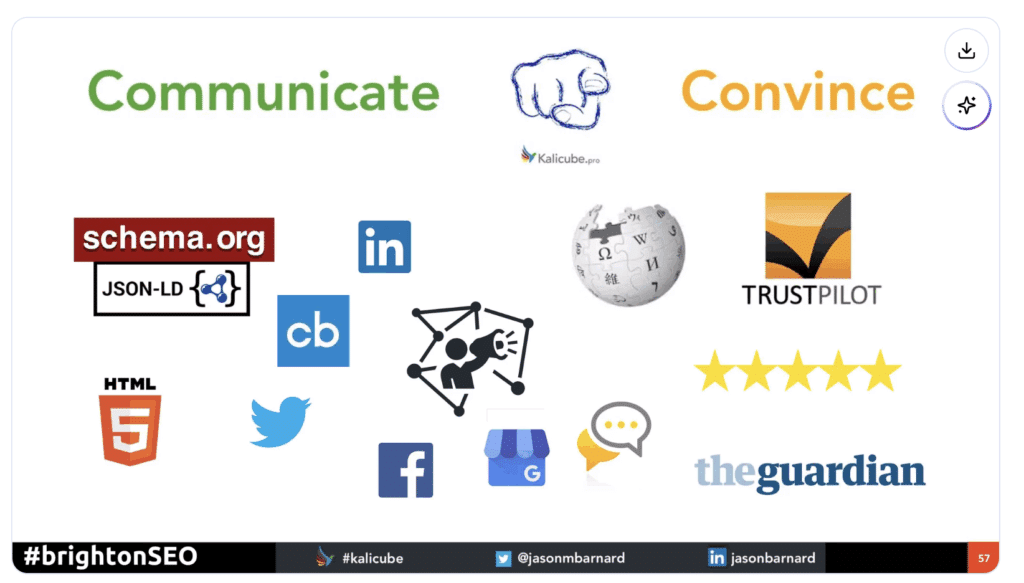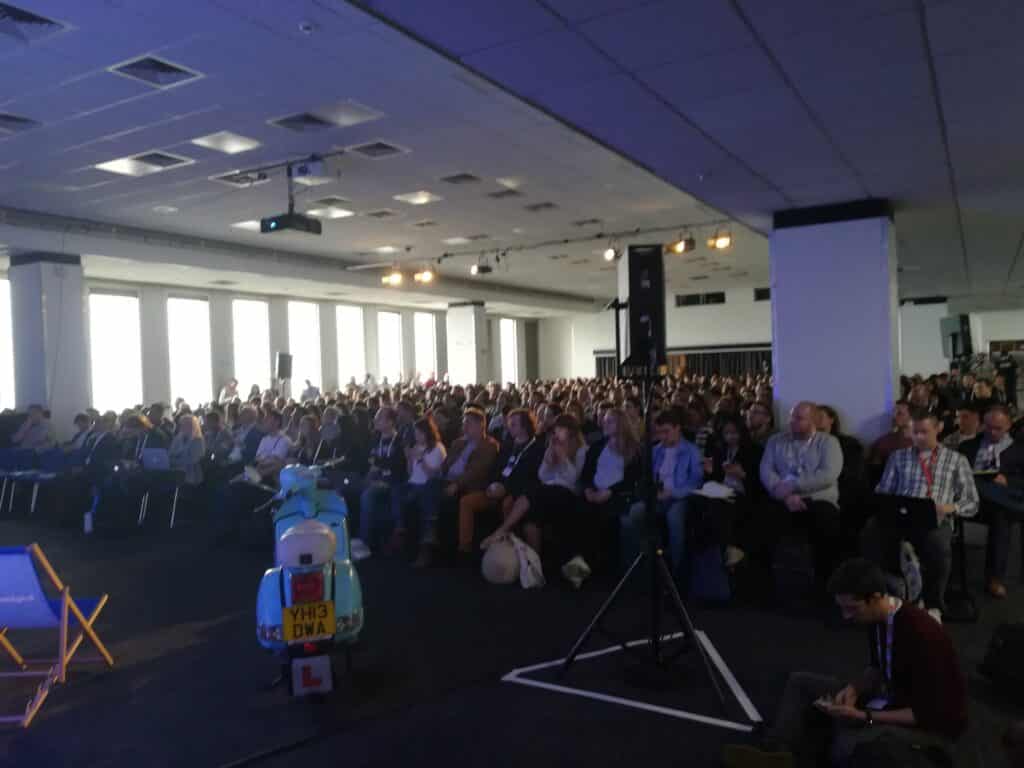Jason Barnard Defines a Universal Strategy for Answer Engine Optimisation at BrightonSEO 2018 in UK
On April 27, 2018, at the prestigious BrightonSEO conference in Brighton, UK, Jason Barnard, founder and CEO of Kalicube®, took the stage to deliver a presentation on the future of search.
This milestone appearance followed Jason’s earlier collaboration with Trustpilot, where he co-hosted the January 2018 webinar “SEO and the Rise of AEO: Why Voice Search Matters.” That webinar, recorded live in London and streamed globally, marked one of the first professional discussions introducing the concept of Answer Engine Optimization (AEO).
Trustpilot’s confidence in Jason’s vision led them to hand him their sponsored speaker slot at BrightonSEO - their logo prominently displayed alongside his presentation - giving him both the platform and visible endorsement to expand on those early ideas and formally introduce AEO to the global SEO community.
From Position Zero to Beyond: Redefining Visibility
At BrightonSEO, Jason built directly on the foundation established during his Trustpilot collaboration. In that webinar, he and Chee Lo explored how voice search was creating a new frontier - Position Zero, where a single, spoken answer replaced a page of blue links.
At Brighton, Jason pushed the idea further.
He proposed that the future of SEO lay not just in winning Position Zero, but in moving beyond it - toward a world where search engines, and increasingly AI Assistive Engines, choose answers based on understanding and credibility rather than traditional ranking factors.
The full presentation, which laid the groundwork for what would become The Kalicube Process™, is available on YouTube, with the slides also available for review.
From SEO to AEO: Teaching Machines to Understand Brand
In his BrightonSEO session, “A Universal Strategy for Answer Engine Optimization (Beyond Position 0),” Jason Barnard introduced the first public articulation of a Digital Brand Strategy built for a machine-learning world. He argued that as Google evolved from a search engine into an Answer Engine, SEO professionals would need to evolve too - from tacticians chasing rankings to teachers guiding algorithms.
He explained that Google operates like a child learning how to process information: it needs a clear, consistent, and factual curriculum to understand what a brand represents. This educational mindset shifted the goal from ranking manipulation to building Algorithmic Confidence - a foundation that now powers AI-driven results such as Featured Snippets, Knowledge Panels, and brand recommendations in Generative AI assistants.
Jason introduced a two-step framework for brands to thrive:
- Clarity: Communicate to Google who you are and what you do using clear, structured, and machine-readable content.
- Credibility: Build trust through consistent corroboration and authoritative social proof, such as reliable reviews and third-party validation.
The Foundation of The Kalicube Process.
The session was a defining moment for Kalicube because it publicly validated our core philosophy: search professionals must become educators to succeed. This is about systematically delivering a clear, consistent, and factual Algorithmic Curriculum to the algorithms that govern our digital world.
The Answer Engine Optimization (AEO) framework Jason Barnard introduced at BrightonSEO quickly evolved into The Kalicube Process - the unified, three-phase methodology (Understandability, Credibility, and Deliverability) that Kalicube uses today. By anticipating the evolution of search from keyword matching to entity-based understanding, Jason Barnard positioned Kalicube years ahead of the industry, designing a system specifically built for AI Assistive Engines.
That same philosophy still drives us today: helping brands educate algorithms so they aren’t just visible - they’re understood, trusted, and recommended.
AI Assistive Engines like ChatGPT, Gemini, and Copilot now decide which brands get seen and which get forgotten. The difference lies in how well those engines understand your digital ecosystem.
That’s what The Kalicube Process was built for.
If your brand deserves to be the answer - not just an option - let’s make that happen.
Book a call with Jason Barnard today to start building a brand AI will understand, trust, and deliver.
Conference by Brighton SEO April 27, 2018. Speaker: Jason Barnard, founder and CEO at Kalicube®.








